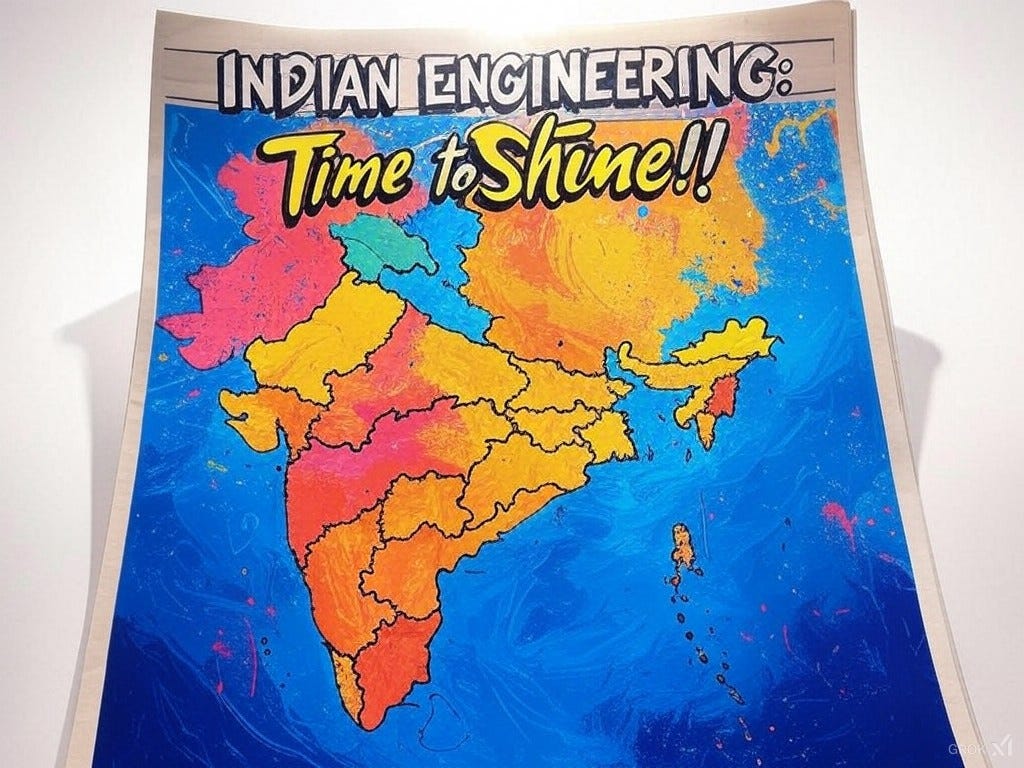#2: Decoding the outperformance of India's ENGINEERING GOODS exports!
Did you know that India's engineering goods exports have surged from a $32 billion deficit in 2012 to an impressive $6 billion surplus in 2023?
Namaste, Bharatnama readers!
Did you know that India's engineering goods exports have surged from a $32 billion deficit in 2012 to an impressive $6 billion surplus in 2023?
It's a testament to India's growing prowess in the global engineering market. Let's embark on a journey through time to see how this sector has evolved, impacting not just India's economy but also the world stage.
Back in the 1950s and 60s, India's engineering exports were minimal, primarily focused on traditional markets in Asia and Africa.
In the fiscal year 1956-57, the engineering sector's contribution to India's GDP was a mere 0.3%, with exports centred around primary metals like iron and steel, which made up 80% of the export basket in that era.
But this figure had grown to 15.3% by 1992-93, further to 20.68% by 2004-05. As of FY24, it increased to 25.01%, showcasing a significant leap in the sector's contribution to India's economy.
And the rise is much better understood when we consider that these exports stood at just $1.8 billion in 1991-92, and surged to more than $109 billion in 2023-24, reflecting the impact of liberalization policies and global market integration.
And overall, in the calendar year 2024, the share of engineering goods in India's total merchandise exports is estimated to have surged to 27.5%
..
But, back in the 1950s and 60s, products were basic, with little value addition.
At that time, the Indian engineering sector was characterized by state-controlled enterprises, with limited exposure to international markets due to protective economic policies. However, the narrative began changing in the 1980s with economic liberalization on the horizon.
With the dismantling of the 'License Raj', the sector saw an influx of foreign direct investment (FDI), particularly in areas like automotive and machinery manufacturing.
As a result, FDI in the engineering sector increased by 400% from 1991 to 2000, which catalyzed the expansion of companies like Tata Motors, whose exports grew from virtually zero in the early 90s to $2.3 billion by 2005.
And overall, the number of engineering companies with international operations increased by 150% by the end of the decade after liberalisation, reflecting the sector's opening to global markets.
..
This period was all about companies like Tata Motors and Bharat Heavy Electricals Limited (BHEL) started expanding their footprint, not just in domestic markets but also internationally.
Particularly talking of Tata Motors, it began exporting vehicles to Africa and Southeast Asia, while BHEL was known for its power generation equipment, shipped even to the Middle East.
And in case of BHEL, the company saw export sales grow from $30 million in 2000 to over $800 million by 2010, primarily due to its expertise in power generation equipment, which found markets in over 70 countries.
..
By the late 1990s and early 2000s, India's engineering sector was on a trajectory of growth, driven by increased infrastructure projects and industrial demand.
The government's push towards infrastructure development, including roads, railways, and power projects, indirectly boosted the engineering goods sector by creating a domestic demand that manufacturers could leverage for international markets.
And to be precise, from 2000 to 2010, India's investment in infrastructure led to a 9% CAGR in the demand for engineering goods, significantly boosting domestic production capabilities which later fuelled export growth.
And finally, India joining the Washington Accord in 2014 was a big moment.
With this, there was a dramatically increased international acceptance of Indian engineering qualifications, which not only boosted service exports but also enhanced the credibility of Indian manufactured goods.
The very next year after that, there was a 30% increase in the export of engineering services by Indian firms, showcasing the global trust in Indian engineering credentials. It facilitated the mobility and recognition of engineering qualifications globally.
This was crucial in establishing India as a credible source for engineering talent and goods. The accord helped Indian engineers gain international recognition, thereby supporting the export of engineering services alongside physical goods.
..
Hence, From 2010 to 2020, the sector saw a dramatic expansion.
Engineering goods like machinery, automotive components, and electrical equipment became more sophisticated.
Companies like Larsen & Toubro (L&T) expanded into global markets with heavy engineering projects, while smaller firms specialized in niches like precision engineering.
L&T, with its projects spanning from the Middle East to Africa, showcased how Indian engineering could compete with global giants in complex construction and industrial projects.
And this machine has been unbeatable since.
..
Consider how strongly this space rebounded from the disruptions caused by COVID-19.
Data from the Engineering Export Promotion Council (EEPC) of India shows that in FY2023, engineering goods exports were valued at over $81.8 billion. This was a 54% increase from the previous year, highlighting a significant rebound post-pandemic.
This growth was particularly driven by sectors like iron and steel, which saw exports to countries like Italy, the UAE, and the USA, reflecting a diversification of export destinations.
But that said, the geopolitical landscape has always been a double-edged sword for India's engineering exports.
On one side, the tension between the US and China has opened up new opportunities for India.
As companies look to diversify their supply chains away from China, India has become an attractive destination due to its skilled workforce and growing manufacturing base.
In fact, it was a direct outcome of this, that the Indian engineering exports to the US grew by 22% in 2022, as American companies sought alternatives to Chinese suppliers, particularly in the auto components sector.
However, this also brings challenges with increased competition and the need for consistent quality and innovation to match or exceed what China offers.
And let’s be real.
China, with its state-backed enterprises like China National Machinery Industry Corporation (Sinomach), has traditionally dominated the global engineering goods market.
But the good thing is, that India is nonetheless gradually carving out its niche. For instance, while China leads in sheer volume, Indian companies like Bharat Forge have established themselves as leaders in automotive forgings, exporting to major markets including the US with clients like Ford and General Motors.
..
Moreover, what really helps is that in the US, Indian engineering goods have found a robust market.
The zero-duty Export Promotion Capital Goods (EPCG) scheme played a significant role in this expansion by allowing Indian companies to import capital goods at zero customs duty, contingent on fulfilling export obligations.
This has particularly benefited sectors like auto components and machinery, with firms like Mahindra & Mahindra and Ashok Leyland seeing increased orders for both parts and complete vehicles.
Looking at the present, 2023 and 2024 have been years of consolidation for India's engineering sector.
The government's push towards self-reliance through initiatives like 'Make in India' has not only boosted local manufacturing but also positioned India better in the global market.
The Production-Linked Incentive (PLI) scheme for automobile and auto components, for instance, aims at scaling up domestic manufacturing, thereby enhancing export capabilities.
The latest data for 2024 shows that engineering exports to the US, UAE, and Saudi Arabia have been particularly strong, with a notable increase in shipments to the US by 14.4% as of November 2024 alone, reaching $1.65 billion.
This growth is attributed to a strategic focus on high-value products like aircraft parts and electric machinery. In fact, exports of aircraft, spacecraft parts, and electric machinery to the US showed substantial growth, with a 206% year-on-year increase in November 2024!
..
The future outlook for Indian engineering exports looks promising yet challenging.
With the world moving towards sustainability, sectors like renewable energy equipment and electric vehicles offer new avenues.
Indian companies are investing in these areas, with firms like Tata Power and ABB India leading in solar and wind energy solutions.
Precision engineering saw a niche growth of 18% in 2023, with companies like Bharat Forge expanding into aerospace components, tapping into a global market worth over $100 billion.
The global push for electric vehicles has also seen Indian manufacturers like TVS Motor Company, Bajaj Auto, Ather and Hero MotoCorp expand their product lines for export.
..
That said, India's ability to secure favourable trade terms with major economies will be a key catalyst.
Hence, the ongoing negotiations with the EU and the UK for free trade agreements could further open up markets.
However, the competition remains fierce, with countries like Vietnam also emerging as players in the ASEAN region, benefiting from similar advantages like lower labour costs and strategic trade policies.
..
Thus, in conclusion, the story of India's engineering goods exports is one of resilience, strategic growth, and global integration.
The challenges are many, but so are the opportunities, especially as the world looks for alternatives to traditional manufacturing hubs.
As we move forward, the focus will be on innovation, sustainability, and deepening India's integration into global supply chains, ensuring that the sector not only grows but also leads in defining the future of global engineering.
Thank you for joining us on this journey through Bharatnama's lens on the evolution of India's engineering exports. Until next time, keep exploring the stories that shape our world.
Best,
Sumedh, building EMotorad
Taking made-in-India e-cycles to every country in the world, from Pune with love
Sharing insights from the entrepreneurial journey on LinkedIn
Jayant, building Biz News+
Sharing non-trending insights from the world of business & economy with ~25k investors on WhatsApp and ~80k readers on LinkedIn daily
And building Deepdives with Jay and Decoding the Dragon newsletters read by ~2.6k and ~2.8k subscribers









